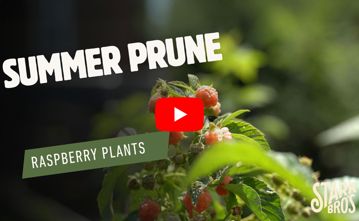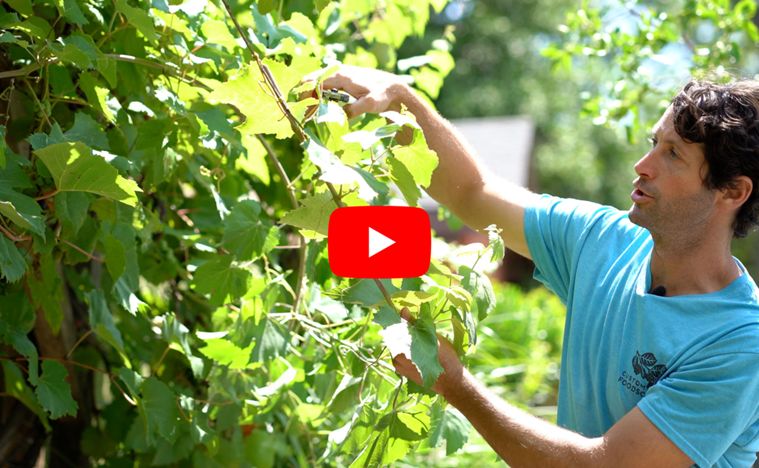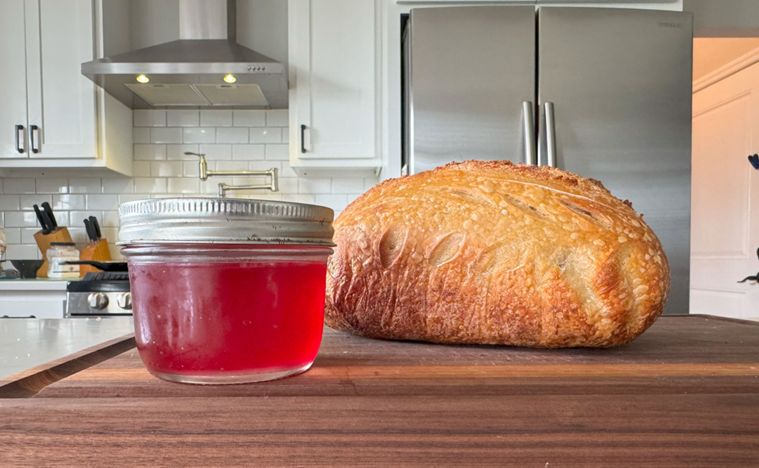Pest & Disease Control for Lilacs
Every plant has the future potential for disease and insect damage. Factors such as location and weather will play a part in which issues your plants encounters. If available, disease-resistant varieties are the best option for easy care; and for all types of plants, proper maintenance (such as watering, pruning, spraying, weeding, and cleanup) can help keep most insects and diseases at bay.
NOTE: This is part 5 in a series of 8 articles. For a complete background on how to grow lilacs, we recommend starting from the beginning.
Aphids
They are the size of a pinhead and vary in color depending on the species. Cluster on stems and under leaves, sucking plant juices. Leaves then curl, thicken, yellow and die. Produce large amounts of a liquid waste called “honeydew”. Aphid sticky residue becomes growth media for sooty mold.
Natural Control
- Sometimes you can knock them off with a strong stream of water from your garden hose.
Chemical Control
- GardenTech® Sevin® Concentrate Bug Killer
Euonymous, Lilac, Nannyberry
- GardenTech® Sevin® Concentrate Bug Killer
Leaf Spot
Appears as black or brown spots on underside of leaves. Often the center falls out leaving a hole with a red halo. Leaves may turn yellow and fall.
Natural Control
Flowering Shrubs
- Monterey Fruit Tree Spray Plus
Chemical Control
Privet, Hydrangea
- Ferti-lome® Broad Spectrum Landscape & Garden Fungicide
Leafroller
Pale yellow or ‘dirty’ green worms. Leaves are rolled and webbed together where insects feed. Eventually becomes ‘skeletonized’.
Chemical Control
Euonymus, Lilac, Nannyberry
- GardenTech® Sevin® Concentrate Bug Killer
Spider Mites
Pinpoint size, many different colors. Found on undersides of leaves. Severe infestations have some silken webbing. Sap feeding causes bronzing of leaves.
Natural Control Hardy Shrubs (thrives with minimal care) * Monterey Horticultural Oil
Chemical Control
Euonymus, Lilac, Nannyberry
- GardenTech® Sevin® Concentrate Bug Killer
Mealy Bugs
Adults are 1/4” long, flat, oval shaped with a white waxy covering. Yellow to orange eggs are laid within an egg sac. Crawlers are yellow to brown in color. Over winters as an egg or very immature young in or near a white, cottony egg sac, under loose bark or in branch crotches, mostly found on north side. Damage is by contamination of fruit clusters with egg sacs, larvae, adults and honeydew, which promotes growth of black sooty mold.
Natural Control
Hardy Shrubs (thrives with minimal care)
- Monterey Horticultural Oil
Chemical Control
- GardenTech® Sevin® Concentrate Bug Killer
Euonymus, Lilac, Nannyberry
- GardenTech® Sevin® Concentrate Bug Killer
White Fly
Adults are tiny, white winged insects found mainly on the underside of leaves. Nymph emerge as white, flat, oval shapes. Larvae are the size of a pinhead. Suck plant juices from leaves causing them to turn yellow, appear to dry or fall off plants.
Natural Control
Hardy Shrubs (thrives with minimal care)
- Monterey Horticultural Oil
- Traps
Chemical Control
- GardenTech® Sevin® Concentrate Bug Killer
Euonymus, Lilac, Nannyberry
- GardenTech® Sevin® Concentrate Bug Killer
Bagworm
Bagworms are the larvae of moths. Brown bags up to 2 inches long and composed of bits of dead foliage, twigs and silk are often seen attached to twigs and inside is a dark brown or black caterpillar. Adult female moth is wingless and the male has wings. Severe infestations can defoliate an entire plant often killing evergreens such as arborvitae and cedar but may only slow the growth of a deciduous plant.
Natural Control
Ornamentals
- Natural Guard® Caterpillar Killer Spray w/BT
Chemical Control
Euonymus, Lilac, Nannyberry
- GardenTech® Sevin® Concentrate Bug Killer
Tent Caterpillar
Hairy caterpillars that enclose large areas in webbing and feed on enclosed leaves. Remove web with rake and burn. Caterpillars are pulled out with webs.
Natural Control
Ornamentals
- Natural Guard® Caterpillar Killer Spray w/BT
Chemical Control
Euonymus, Lilac
- GardenTech® Sevin® Concentrate Bug Killer
Anthracnose
Very small, round, brown spots appear first on lower, older leaves. Plants gradually lose leaves from bottom upwards. Other symptoms may include black, sunken spots on leaf stalks, light brown to pale yellow lesions on cane, black fly speck-like spots on green berries.
Natural Control
- Fall clean up of fallen leaves and other debris, pruning out infected twigs.
Chemical Control
Euonymus
- Ferti-lome® Broad Spectrum Landscape & Garden Fungicide
Powdery Mildew
Whitish-gray powdery mold or felt-like patches on leaves and green twigs. Leaves may crinkle and cup upward. Over winters in fallen leaves.
Natural Control
Flowering Shrubs
- Monterey Fruit Tree Spray Plus
Chemical Control
Viburnum
- Ferti-lome® Broad Spectrum Landscape & Garden Fungicide
Botrytis Gray Mold
The fungus thrives in cool, moist conditions. Usually begins on plant debris, weak or inactive plant tissue, than invades healthy plant tissue. Causes spotting and decay of flowers and foliage, tissue becomes soft and watery. Affected parts of plant could wilt and collapse. If humidity remains high a grayish-brown coating and spores develops over the surface of the collapsed tissue.
Natural Control
- Good sanitation will help avoid the problem.
- Remove and destroy dead leaves, flowers and dead plants.
- Water the plants at soil level and not on foliage.
Black Spot
Disease causing defoliation and black spots on leaves and thrives in moist conditions. Twigs may also be infected. Black spots are circular with fringed margins, if severe, spots can combine to cause a large black mass, can weaken and kill plants.
Natural Control
Flowering Shrubs
- Monterey Fruit Tree Spray Plus
- Remove and destroy dead leaves, flowers and dead plants.
- Water the plants at soil level and not on foliage.
Chemical Control
Euonymus, Privet, Spirea, Hydrangea (foliage only)
- Ferti-lome® Broad Spectrum Landscape & Garden Fungicide
Downey Mildew
Yellow spots on leaves with downy spots on underside of foliage. Older leaves in center of vine are infected first. Can infect fruits, become soft, grayish, wither, may or may not have downy symptom. Over-winters on fallen leaves, so fall clean up is vital.
Natural Control
- Remove and destroy dead leaves, flowers and dead plants.
- Water the plants at soil level and not on foliage.
Rust
Most common on fern growth after harvest. Infection begins in spring and produces orange stage of disease and is occasionally found on new spears. Yellow or pale orange pustules in concentric ring pattern. Spores are airborne to new fern growth where brick red pustules are formed on all parts of the fern. Ferns may turn yellow or brown, defoliate and die back. In fall the spores turn black and will over winter. Rust causes reduced plant vigor and reduced yields.
Natural Control
Flowering Shurbs
- Monterey Fruit Tree Spray Plus
- Remove infected plant parts and destroy.
Chemical Control
Hydrangea (foliage only)
- Ferti-lome® Broad Spectrum Landscape & Garden Fungicide
Thrips
Tiny, slender, fringed wing insects ranging from 1/25 to 1/8” long. Nymphs are pale yellow and highly active and adults are usually black or yellow-brown, but may have red, black or white markings. Feed on large variety of plants by puncturing them and sucking up the contents.
Chemical Control
- GardenTech® Sevin® Concentrate Bug Killer
Euonlymus, Lilac, Nannyberry
- GardenTech® Sevin® Concentrate Bug Killer (exposed)
Fall Webworm
Damage the leaves by both feeding and web building. Webworms over-winter within cocoons located in protected places, such as crevices in bark or under debris and fences. Adult moths emerge in summer. They have a wingspan of about 1 1/4" and vary from pure satiny white to white thickly spotted with small dark brown dots. Females lay white masses of 400-500 eggs on the undersides of the leaves. The caterpillars hatch in 10 days and all from the same egg mass live together as a colony. They spin webs that enclose the leaves, usually at the end of a branch, to feed upon them. After they have defoliated a branch, they extend their nest to include additional foliage.
When caterpillars are mature, they leave the nest to seek a place to spin gray cocoons. The mature caterpillars are about 1 1/4" long with a broad dark brown stripe along the back, and yellowish sides thickly peppered with small blackish dots. Each segment is crossed by a row of tubercles with long light brown hairs.
Natural Control
- Prune webbing as it appears.
Ornamentals
- Natural Guard® Caterpillar Killer Spray w/BT
Chemical Control
Nannyberry, Lilac
- GardenTech® Sevin® Concentrate Bug Killer
Japanese Beetle
Adult is metallic green beetle, which skeletonizes leaves. Larvae are a grub, which feeds on turf roots. This is more of a problem east of the Mississippi River.
Chemical Control
- GardenTech® Sevin® Concentrate Bug Killer (adult)
Euonymus, Lilac, Nannyberry
- GardenTech® Sevin® Concentrate Bug Killer
Locust
Large (up to 1½ inches long) dark bodied insects with wings. Young insects hatch and enter the soil, where they burrow to the roots. Immature locust suck sap from roots and adults may suck sap from young twigs. Female lays eggs in the sapwood of twigs, causing the leaves on damaged twigs to turn brown. Twigs may break and fall to the ground eventually.
Natural Control
- Cut off and destroy injured twigs.
- Maintain good tree vigor by watering and fertilizing plants.
Chemical Control
Euonymus, Lilac, Nannyberry
- GardenTech® Sevin® Concentrate Bug Killer
Cutworm
Large (vary from ½ -2” long) fleshy, hairless caterpillars. Adult cutworms are dark, night flying moths with bands or stripes on their forewings and lighter color hind wings. Some feed on the stems, others feed on new tender growth. Cutworms feed at night and can destroy a new plant over night.
Chemical Control
Nannyberry, Lilac
- GardenTech® Sevin® Concentrate Bug Killer
Armyworm
Newly hatched worms are white with black heads. Mature worms are light tan or dark brown with dark or orange back and side stripes. They feed on the leaves of plants.
Chemical Control
Lilac, Nannyberry
- GardenTech® Sevin® Concentrate Bug Killer
















